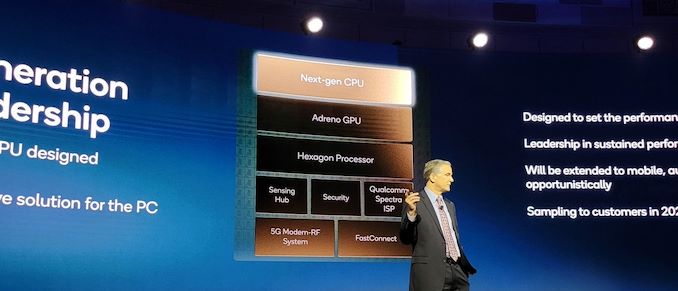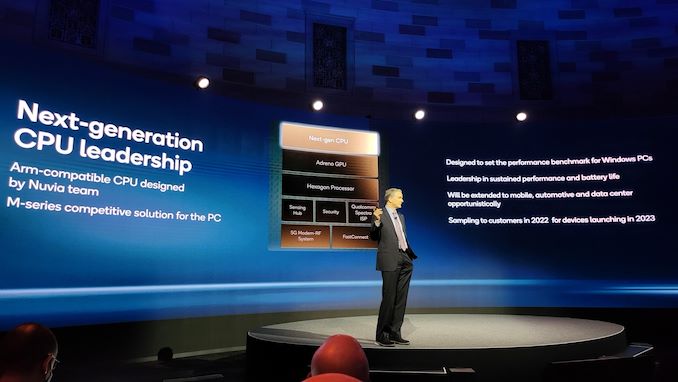Qualcomm x Nuvia: Silicon Sampling in Late 2022, Products in 2023
by Dr. Ian Cutress on November 18, 2021 12:15 PM EST- Posted in
- CPUs
- Snapdragon
- Arm
- Qualcomm
- Laptops
- Notebooks
- Windows on Snapdragon
- NUVIA
- ARMv9

One of the more curious acquisitions in the last couple of years has been that of Nuvia by Qualcomm. Nuvia was a Silicon Valley start-up founded by the key silicon and design engineers and architects behind both Apple’s and Google’s silicon for the past few years. Qualcomm CEO Cristiano Amon made it crystal clear when Nuvia was acquired that they were going after the high-performance ultraportable laptop market, with both Intel and Apple in the crosshairs.
Nuvia came out of stealth in November 2019, with the three main founders having spent almost a year building the company. Gerard Williams III, John Bruno, and Manu Gulati have collectively driven the silicon design of 20+ chips, have combined over 100 patent, and have been in leadership roles across Google, Apple, Arm, Broadcom, and AMD. Nuvia raised a lot of capital, $300M+ over two rounds of funding and angel investors, and the company hired a lot of impressive staff.
The goal of Nuvia was to build an Arm-based general purpose server chip that would rock the industry. Imagine something similar to what Graviton 2 and Ampere Altra are today, but with a custom microarchitecture on par (or better) with Apple’s current designs. When Nuvia was still on its own in start-up mode, some were heralding the team and the prospect, calling for the downfall of x86 with Nuvia’s approach. However, Qualcomm swept in and acquired the company in March 2021, and repurposed Nuvia’s efforts towards a laptop processor.
It’s been no secret that Qualcomm has been after the laptop and notebook market for some time. Multiple generations of ‘Windows on Snapdragon’ have come to market through Qualcomm’s partners, initially featuring smartphone-class silicon before becoming something more bespoke with the 8cx, 8cx Gen 2, and 7c/7 options in the past couple of years. It has taken several years for Qualcomm to get the silicon and the Windows ecosystem somewhere that makes sense for commercial and consumer use, and with the recent news that Windows 11 on these devices now enabling full x86-64 emulation support, the functional difference between a Qualcomm laptop and an x86 laptop is supposed to be near zero. Qualcomm would argue their proposition is better, allowing for 2 days of use on a single charge, holding charge for weeks, and mobile wireless connectivity with 4G/5G. I’ve tested one of the previous generation S855 Lenovo Yoga devices, and the battery life is insane – but I needed better were functional support (turns out I have an abnormal edge-case work flow…) and more performance. While Qualcomm has been working on the former since my last test, and Nuvia is set to bring the latter.

Image from @anshelsag on Twitter, Used with permission
At Qualcomm’s Investor Day this week, the Qualcomm/Nuvia relationship was mentioned in an update. I had hoped that by the end of this year (and Qualcomm’s Tech Summit in only a couple of weeks) that we might be seeing something regarding details or performance, however Qualcomm is stating that its original schedule is still on track. As announced at the acquisition, the goal is to deliver test silicon into the hands of partners in the second half of 2022.
The goal here is to have laptop silicon that is competitive with Apple's M-series, but running Windows. This means blowing past Intel and AMD offerings, and coupled with the benefits of better battery life, sustained performance, and mobile connectivity. From the disclosures so far, it’s perhaps no surprise that the Nuvia CPUs will be paired with an Adreno GPU and a Hexagon DSP, although it will be interesting to see if the Nuvia CPU is a single big core paired with regular Arm efficient cores, or everything in the CPU side will be new from the Nuvia team.
I have no doubt that at Qualcomm’s Tech Summit in December 2022 we’ll get a deeper insight into the microarchitecture of the new core. Either that or Qualcomm might surprise us with a Hot Chips presentation in August. With regards to going beyond laptop chips, while Qualcomm is happy to state that Nuvia's designs will be 'extended to [other areas] opportunistically', it's clear that they're locking the crosshairs on the laptop market before even considering what else might be in the field of view.










50 Comments
View All Comments
ikjadoon - Thursday, November 18, 2021 - link
Because the major microarchitecture for Phoenix was finished in 2020 likely—their performance simulations were beating A13 in perf/watt. Just like Zen1 couldn’t beat Skylake. It’s not like AMD tried to fail: they just needed another few generations. And then Intel came back.I hope NUVIA does well, but let’s wait for benchmarks first. 🤝
High perf + perf/watt is the goal. Anyone can get higher perf/watt than AMD/Intel, while you can play with numbers to beat Apple’s perf/watt.
OreoCookie - Thursday, November 25, 2021 - link
IMHO you are looking at the wrong company, their competitor is mainly Intel, not Apple. If they soundly beat Intel cpus in performance-per-watt and are comparable or better in terms of absolute performance, they have a winner on their hands.Spleter - Monday, December 13, 2021 - link
what if Windows 11 Arm version is free from rumored Qualcomm contractual exclusivity by 2022 or 2023?CrystalCowboy - Thursday, November 18, 2021 - link
"but I needed better were functional support" - this clause needs something, but I can't figure out exactly what.CrystalCowboy - Thursday, November 18, 2021 - link
But will it Linux?vlad42 - Thursday, November 18, 2021 - link
Like essentially all other ARM chips, it will likely require custom images to boot. So, I would expect Linux support to take a while. Also, lets not forget Qualcomm's terrible support strategy. They will probably require companies to pay for driver support just like on Android. So, the Linux community will also have to reverse engineer all the drivers before it is usable.Diogene7 - Thursday, November 18, 2021 - link
Do we have any idea of what fab and node do they intend to use for the chip ?Will it be Samsung 3GAE (which could nice if Samsung GAA transistors implementation does really happen to be more energy efficient than 3nm FinFet) or will it be TSMC 3nm ? Any of those 2 nodes should provide a better energy efficiency versus Intel 7 or TSMC 5nm (AMD)…
I hope it won’t be Samsung 5nm, neither TSMC 5nm because by end of 2022, Apple will very likely begin to transition to TSMC 3nm node and it is likely the Nucia designed chip would be at a disavantage versus Apple…
NextGen_Gamer - Thursday, November 18, 2021 - link
Looking at their timeframe, of only delivering limited samples to customers in Q3 2022 and not starting mass production for consumers until 2023, I would assume they are targeting 3-nm. If they want to have any hope of matching Apple, they know 3-nm will be needed because Apple has jumped to each new process node as fast as it can for a number of years now. Qualcomm uses both Samsung and TSMC, so it is anyone's guess as to which they might use.Blastdoor - Friday, November 19, 2021 - link
Apple and Intel might have booked all 3nm capacity for a whileSilver5urfer - Thursday, November 18, 2021 - link
More Hot Air BS claims by Qcomm, lets recall how the Centriq was heralded as next generation and marketed as well. And where is that ? Dead and they even axed the whole thing down along with Staff, chief people.Nuvia is now the next miracle of the Computing era ? yeah sure Qcomm. Fool us once but fool us second time ? Apple M1 got destroyed by all Mobile laptops in the general workloads yeah it's fast on the Cinebench and when loading applications which are not made optimized for Apple silicon is not great. And gaming performance was slaughter fest, a 3060 destroyed it.
Qcomm cannot even beat Apple, all the CPUs are like a generation behind, yeah application performance is similar apart from SPEC leadership but still they are slow. Apple destroys them.
Alder Lake despite it's massive flaws like E cores being only relegated to SMT workloads and not gaming, and new DDR5 etc. The performance is great on P cores which is what really matters and they will slaughter Apple processors. Even at 57Billion transistors in SoC they are marginally at best, and this joke Qualcomm will beat all that ? And PC is Desktop LGA not some BGA crapware with limited power and limited everything.
Finally Software. Where is 8cX ? Dead, nowhere to be found and Win11 is now 64-bit x86 emulation, and with Intel Big little and Zen 4c it's not possible for this junk to exist., esp the whole nonsensical emulation part.